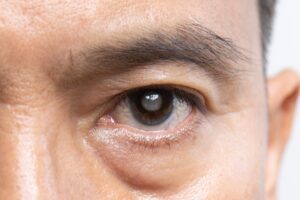The body produces and uses insulin to effectively control blood sugar (glucose) levels. Diabetes is a disease that directly affects the body’s ability to produce the required insulin. Diabetes can affect and damage multiple areas of the body including the heart, kidneys, and blood vessels. In addition, it can also damage the small blood vessels in the eye.
A range of diabetic eye disease manifestations can result once an individual has diabetes. Even with proper diabetes care, it can still affect an individual’s eye care and overall health. Northeast Ohio Eye Surgeons is here to provide you with a helpful guide to diabetic eye disease.
Types of Diabetic Eye Disease
Here are the four types of diabetic eye disease that can affect an individual’s eye health:
Diabetic Retinopathy
Due to damaged blood vessels within the retina, this form of diabetic eye disease known as “diabetic retinopathy” can crop up. In the early stages of this diabetic eye disease, blood vessels can bulge, weaken, or leak into the retina. This is called nonproliferative diabetic retinopathy. This is not always noticeable to the patient as a change in vision and it will never cause discomfort or pain. This form of diabetic eye disease is detected during an annual dilated eye exam.
If the disease worsens, the proliferative diabetic retinopathy stage kicks in. At this point, some blood vessels close off and new abnormal ones can grow, causing serious vision problems. The individual in this stage usually notices large blotches in their vision.
Diabetic Macular Edema
Diabetic macular edema is when diabetes causes swelling to the part of the retina known as the “macula” which is like the center bullseye of the retina. The macula helps us read, drive, and see faces. Macular edema typically develops in those with signs of diabetic retinopathy. Over time if left untreated, macular edema can destroy the sharp vision in this part of the eye and can lead to central vision loss.
Cataracts
Those with diabetes are more likely to develop cloudy lenses known as cataracts. The lenses within an individual’s eyes are clear structures that help provide sharp vision. High glucose levels cause build-up in the lenses of the eye and lead to cloudiness and faded colors that can only be remedied with cataract removal/surgery. .
Glaucoma
Diabetes increases the risk of developing glaucoma, a group of eye diseases that can damage the optic nerve. The optic nerve is a bundle of nerves that connects the eyes to the brain. If not treated early on during the disease process, glaucoma can lead to peripheral vision loss and eventually to blindness. Symptoms depend on the type of glaucoma an individual has and is best detected during an annual eye exam.
Prevention and Early Detection
To help prevent these various diabetic eye diseases, individuals should maintain good control of their blood sugar and blood pressure and lower their cholesterol. To better detect these problems early on, schedule an eye exam with an eye care provider and don’t neglect follow-up appointments.
Managing Diabetic Eye Diseases
Do you or someone you love have any of these diabetic eye problems? Here are some ways to help manage them:
Lifestyle Changes
One way to help manage diabetic eye disease is by making several lifestyle changes. The key is keeping blood sugar levels under control to help manage diabetes and the effects of the disease on the eye and the body. This can be achieved by cutting out tobacco, which increases the amount of sugar in your blood and weakens the blood vessels in the eye. Also, aerobic exercise at 20 minutes a day or 150 minutes a week can help control blood sugar levels.
Medical Treatments
There are medical treatments to manage proliferative diabetic eye disease and diabetic macular edema that include medicines such as anti-VEGF injections into the eye like aflibercept, bevacizumab, or ranibizumab. These medications block the growth of abnormal blood vessels in the eye that are harmful to the eye.
An additional route would be laser treatment. These laser treatments create tiny burns inside the eye with a beam of light that treats leaky blood vessels and extra fluid. These treatments can help these diabetic eye complications from getting worse to prevent vision loss and blindness. Focal/grid laser treatment treats diabetic macular edema and scatter laser treatment treats proliferative diabetic retinopathy.
A vitrectomy is a surgery that treats problems with severe bleeding (vitreous hemorrhaging) caused by proliferative diabetic retinopathy by removing the blood and the gel that fills the center of the eye. During the surgery, a clear salt solution is gently injected into the eye to maintain eye pressure during surgery and to replace the removed vitreous. This procedure is only used in very severe cases. Another surgery would be cataract lens surgery if the diabetic patient suffers from vision loss due to cataracts caused by the diabetes. The surgery involves the removal of the cloudy lens where the cataract has grown and replacement with an artificial lens known as an intraocular implant (IOL).
Vision Rehabilitation
If you have already experienced significant vision loss from diabetic eye disease, low-vision rehabilitation clinics exist to help where glasses, contact lenses, medicine, or surgery can no longer help. Special devices and training at these clinics help individuals make the most out of their current vision problems. Northeast Ohio Eye Surgeons offer this type of care in several of our locations.
FAQs
How does diabetes affect the eyes?
Diabetes can affect the eyes by causing issues that lead to poor vision and even blindness due to poor sugar control or length of time the patient has been afflicted with the disease.
Can diabetic eye disease be reversed?
Diabetic eye disease cannot always be fully reversed but can be improved with early intervention and lifestyle changes. Medical treatments can help slow the progression, preserving vision for the long term.
What are the early signs of diabetic eye diseases?
- Blurred vision
- Vision loss
- Fluctuating vision
- Dark or empty areas in your vision
- Spots or dark strings floating in your vision, also known as floaters
How often should diabetics get their eyes checked?
Diabetics should get their eyes checked annually with a dilated eye examination by an optometrist or ophthalmologist.
What treatments are available for diabetic retinopathy?
Depending on the exact condition and severity, diabetic retinopathy can be medically treated with anti-VEGF injections into the eye, by laser treatments or in severe cases by vitrectomy surgery. Lifestyle changes are also important in the treatment of this disease.
How-Tos
How to Manage Blood Sugar Levels
- Make lifestyle changes like cutting out tobacco and incorporating 150 minutes of aerobic exercise throughout the week.
- It’s extremely important to adhere to medication requirements that help manage blood sugar levels and keep regular follow-ups with your primary care physician to monitor this.
- Follow a daily diet and exercise plan from your primary care physician.
How to Protect Your Vision
- See an eye care practitioner annually for a dilated eye exam.
- Call your eye care practitioner ASAP with sudden changes in vision or spots/missing areas of vision that appear.
How to Prepare for an Eye Exam
For a dilated eye exam, the doctor will place drops into the eye to widen the eye’s pupils. Then, the doctor examines the larger area at the back of each eye called the retina, using a special magnifying lens in order to examine the macula and the blood vessels of the eye to look for diabetic eye disease. Vision will be blurry in the eyes for a few hours after the exam because of the eye drops, so it’s important to wear sunglasses afterwards and have someone who can drive you to and from the exam if possible. The doctor will also measure the pressure in your eyes and test your vision.
It’s also important to ask questions after the exam is over. You should ask the doctor if you need to make any lifestyle changes, what symptoms to keep on the lookout for, and what measures you can take going forward to help protect your eyes. The eye care practitioner will send a letter of correspondence to your primary care physician so they are aware you had your annual eye exam as well.
How to Use Vision Assistive Devices
Vision assistive devices such as magnifiers use cameras or lenses to make things look bigger. Anti-glare spectacles minimize glare and task lights help illuminate objects within a certain area to help individuals perform a variety of tasks. These are best suited for a patient when they are prescribed by a vision rehabilitation doctor in the clinic to assure they are the right device for the patient’s needs.
Schedule an Appointment with Northeast Ohio Eye Surgeons
With the diagnosis of diabetes, certain eye problems can occur that can cause vision issues and even blindness. There are ways to help these vision problems like regular eye exams, making various lifestyle changes, medical treatments, and even vision rehabilitation.
Schedule an appointment with Northeast Ohio Eye Surgeons for regular eye care and lifestyle recommendations to help with diabetic eye disease.
















Recent Comments